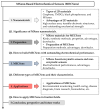Recent Advances in MXene-Based Electrochemical Sensors
- PMID: 39997009
- PMCID: PMC11852424
- DOI: 10.3390/bios15020107
Recent Advances in MXene-Based Electrochemical Sensors
Abstract
MXene is a new family of two-dimensional nanomaterials with outstanding electrical conductivity, tunable structure, biocompatibility, and a large surface area. Thanks to these unique physicochemical properties, MXene has been used for constructing electrochemical sensors (MECSens) with excellent performance. In particular, the abundant surface termination of MXene can contribute to greatly enhancing the analytical sensitivity and selectivity of MECSens. Recently, MECSens have been widely applied in many fields including clinical diagnosis, infectious disease surveillance, and food security. However, not all MXene materials are suitable for building electrochemical sensors. In this article, we present an overview of different MECSens that have been developed so far. We begin with a short summary of the preparation and characterization of MECSens. Subsequently, the electrochemical performance, detection strategies, and application scenarios of MECSens are classified and briefly discussed. The article ends with a short conclusion and future perspectives. We hope this article will be helpful for designing and constructing MECSens with outstanding activity for electrochemical analysis.
Keywords: MXene; application scenarios; electrochemical performance; electrochemical sensor; two-dimensional nanomaterial.
Conflict of interest statement
The authors declare no conflicts of interest.
Figures








Similar articles
-
Advances in MXene-Based Electrochemical Sensors for Multiplexed Detection in Biofluids.Int J Mol Sci. 2025 Jun 3;26(11):5368. doi: 10.3390/ijms26115368. Int J Mol Sci. 2025. PMID: 40508178 Free PMC article. Review.
-
Recent advances in MXene nanozyme-based optical and electrochemical biosensors for food safety analysis.Nanoscale. 2025 Mar 28;17(13):7697-7712. doi: 10.1039/d5nr00066a. Nanoscale. 2025. PMID: 40042242 Review.
-
MXene-Based Electrochemical Biosensors: Advancing Detection Strategies for Biosensing (2020-2024).Biosensors (Basel). 2025 Feb 20;15(3):127. doi: 10.3390/bios15030127. Biosensors (Basel). 2025. PMID: 40136924 Free PMC article. Review.
-
Recent Progress in MXene-Based Materials for Supercapacitors and Electrochemical Sensing Applications.Biosensors (Basel). 2025 May 3;15(5):288. doi: 10.3390/bios15050288. Biosensors (Basel). 2025. PMID: 40422027 Free PMC article. Review.
-
Advanced growth of 2D MXene for electrochemical sensors.Environ Res. 2023 Apr 1;222:115279. doi: 10.1016/j.envres.2023.115279. Epub 2023 Jan 24. Environ Res. 2023. PMID: 36706895
References
-
- Jia Y., Zhang J., Kong D., Zhang C., Han D., Han J., Tao Y., Lv W., Yang Q.-H. Practical Graphene Technologies for Electrochemical Energy Storage. Adv. Funct. Mater. 2022;32:2204272. doi: 10.1002/adfm.202204272. - DOI
-
- Yuan S., Pang S.-Y., Hao J. 2D transition metal dichalcogenides, carbides, nitrides, and their applications in supercapacitors and electrocatalytic hydrogen evolution reaction. Appl. Phys. Rev. 2020;7:021304. doi: 10.1063/5.0005141. - DOI
Publication types
MeSH terms
Substances
Grants and funding
LinkOut - more resources
Full Text Sources

